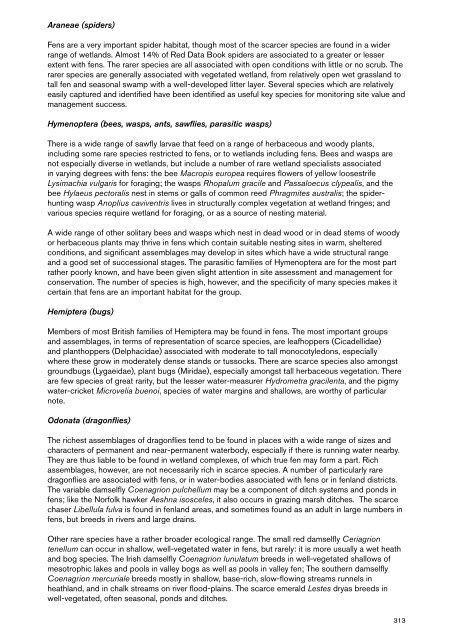Fen Management Handbook - Scottish Natural Heritage
Fen Management Handbook - Scottish Natural Heritage
Fen Management Handbook - Scottish Natural Heritage
You also want an ePaper? Increase the reach of your titles
YUMPU automatically turns print PDFs into web optimized ePapers that Google loves.
Araneae (spiders)<br />
<strong>Fen</strong>s are a very important spider habitat, though most of the scarcer species are found in a wider<br />
range of wetlands. Almost 14% of Red Data Book spiders are associated to a greater or lesser<br />
extent with fens. The rarer species are all associated with open conditions with little or no scrub. The<br />
rarer species are generally associated with vegetated wetland, from relatively open wet grassland to<br />
tall fen and seasonal swamp with a well-developed litter layer. Several species which are relatively<br />
easily captured and identified have been identified as useful key species for monitoring site value and<br />
management success.<br />
Hymenoptera (bees, wasps, ants, sawflies, parasitic wasps)<br />
There is a wide range of sawfly larvae that feed on a range of herbaceous and woody plants,<br />
including some rare species restricted to fens, or to wetlands including fens. Bees and wasps are<br />
not especially diverse in wetlands, but include a number of rare wetland specialists associated<br />
in varying degrees with fens: the bee Macropis europea requires flowers of yellow loosestrife<br />
Lysimachia vulgaris for foraging; the wasps Rhopalum gracile and Passaloecus clypealis, and the<br />
bee Hylaeus pectoralis nest in stems or galls of common reed Phragmites australis; the spiderhunting<br />
wasp Anoplius caviventris lives in structurally complex vegetation at wetland fringes; and<br />
various species require wetland for foraging, or as a source of nesting material.<br />
A wide range of other solitary bees and wasps which nest in dead wood or in dead stems of woody<br />
or herbaceous plants may thrive in fens which contain suitable nesting sites in warm, sheltered<br />
conditions, and significant assemblages may develop in sites which have a wide structural range<br />
and a good set of successional stages. The parasitic families of Hymenoptera are for the most part<br />
rather poorly known, and have been given slight attention in site assessment and management for<br />
conservation. The number of species is high, however, and the specificity of many species makes it<br />
certain that fens are an important habitat for the group.<br />
Hemiptera (bugs)<br />
Members of most British families of Hemiptera may be found in fens. The most important groups<br />
and assemblages, in terms of representation of scarce species, are leafhoppers (Cicadellidae)<br />
and planthoppers (Delphacidae) associated with moderate to tall monocotyledons, especially<br />
where these grow in moderately dense stands or tussocks. There are scarce species also amongst<br />
groundbugs (Lygaeidae), plant bugs (Miridae), especially amongst tall herbaceous vegetation. There<br />
are few species of great rarity, but the lesser water-measurer Hydrometra gracilenta, and the pigmy<br />
water-cricket Microvelia buenoi, species of water margins and shallows, are worthy of particular<br />
note.<br />
Odonata (dragonflies)<br />
The richest assemblages of dragonflies tend to be found in places with a wide range of sizes and<br />
characters of permanent and near-permanent waterbody, especially if there is running water nearby.<br />
They are thus liable to be found in wetland complexes, of which true fen may form a part. Rich<br />
assemblages, however, are not necessarily rich in scarce species. A number of particularly rare<br />
dragonflies are associated with fens, or in water-bodies associated with fens or in fenland districts.<br />
The variable damselfly Coenagrion pulchellum may be a component of ditch systems and ponds in<br />
fens; like the Norfolk hawker Aeshna isosceles, it also occurs in grazing marsh ditches. The scarce<br />
chaser Libellula fulva is found in fenland areas, and sometimes found as an adult in large numbers in<br />
fens, but breeds in rivers and large drains.<br />
Other rare species have a rather broader ecological range. The small red damselfly Ceriagrion<br />
tenellum can occur in shallow, well-vegetated water in fens, but rarely: it is more usually a wet heath<br />
and bog species. The Irish damselfly Coenagrion lunulatum breeds in well-vegetated shallows of<br />
mesotrophic lakes and pools in valley bogs as well as pools in valley fen; The southern damselfly<br />
Coenagrion mercuriale breeds mostly in shallow, base-rich, slow-flowing streams runnels in<br />
heathland, and in chalk streams on river flood-plains. The scarce emerald Lestes dryas breeds in<br />
well-vegetated, often seasonal, ponds and ditches.<br />
313

















